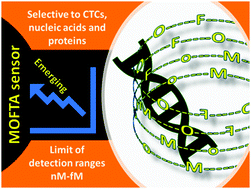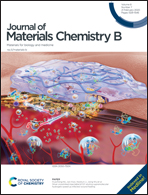Nanoscale metal–organic frameworks in detecting cancer biomarkers
Abstract
Following the efficient performance of metal–organic frameworks (MOFs) as recognition elements in gas sensors, biosensors based on MOFs are now being investigated to capture and quantify potential cancer biomarkers, such as circulating tumor cells (CTCs), nucleic acids and proteins. The current status of MOF-based biosensors in the detection of early stages of cancer is in its infancy, although it has significantly emerged since the beginning of this decade. That said, salient research has been conducted in the past five years to utilize the distinctive porous crystalline structure of MOFs for highly sensitive and selective detection of cancer biomarkers. In this pursual, MOFs designed with bimetallic assembly, doped with magnetic nanoparticles, coated with polymers, and even conjugated with peptides or oligonucleotides have shown promising outcomes in detecting CTCs, nucleic acids and proteins. In particular, aptamer-conjugated MOFs are able to perform at a lower limit of detection down to the femtomolar, implying their efficacy for the point of care testing in clinical trials. In this way, aptasensors based on aptamer-conjugated MOFs present a newer sub-branch, to be coined as a MOFTA sensor in the current review. Considering the emerging progress and promising outcomes of MOFTA sensors as well as a variety of MOF-based techniques of detecting cancer biomarkers, this review will highlight their significant advances and related aspects in the recent five years on the context of detecting CTCs, nucleic acids and proteins for the early-stage detection of cancer.



 Please wait while we load your content...
Please wait while we load your content...